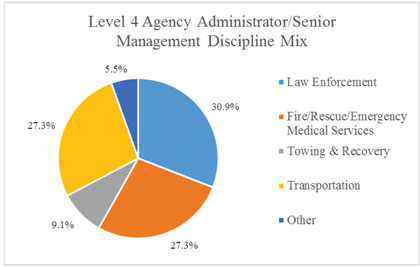Traffic Incident Management Training Post-Course Assessment Tool Final Evaluation Report
CHAPTER 6. LEVEL 4 AGENCY ADMINISTRATOR AND SENIOR MANAGEMENT TRAINING IMPLEMENTATION ASSESSMENTS
Six months to a year after personnel attend a Traffic Incident Management (TIM) training session, Agency Administrators or Senior Management and/or the State or regional points of contact, are asked to complete a results survey. The TIM training results survey assesses the impact on and operational benefits realized by an agency/organization that has sent their personnel through the TIM training.
From inception of the tool through August 15, 2017, a total of 55 individuals had completed Level 4 online surveys. Figure 11 below shows the Agency Administrator/Senior Management discipline mix.

Figure 11. Graph. Level 4 Agency Administrator/Senior Management discipline mix.
The States where the Level 4 Agency Administrators/Senior Managers are based is shown in Figure 12 below.

Figure 12. Graph. Level 4 participant base States.
Average Level 4 Key Metrics
- Percentage of personnel within respondent's agency/organization that have TIM-related duties/responsibilities have received the TIM training: 84 percent (median).
- 47.7 percent of respondents indicate that all or most of the other TIM responder agencies/organizations in their area/region have also implemented the TIM training.
- Average incident clearance time pre-training was 67.5 minutes; average incident clearance time post-training was 54 minutes; representing a 20.2 percent reduction in incident clearance time among reporting agencies.
- Average roadway clearance time pre-training was 65 minutes; average roadway clearance time post-training was 49 minutes; representing a 24.8 percent reduction in roadway clearance time among reporting agencies.
- 92.5 percent of respondents believe that overall agency operations have been improved as a result of personnel attending the SHRP2 TIM training.
- 96.3 percent of respondents believe that overall safety at traffic incidents has been improved as a result of personnel attending the SHRP2 TIM training.
- 87.0 percent of respondents believe that coordination among different agencies at traffic incident scenes has improved since the SHRP2 TIM training.
- 96.3 percent of respondents indicated that their agency/organization has a written policy/directive requiring all personnel to wear high-visibility safety apparel when responding to incidents.
- 90.7 percent of respondents indicated that response vehicles are equipped with traffic cones, flares or other channelizing devices.
- 70.8 percent of respondents indicated that there is a formal TIM program in their area/region supported by a multi-discipline, multi-agency team or task force which meets regularly to discuss and plan for TIM activities.
An additional measure of the success of the TIM training course in affecting change is the integration of the TIM policies and procedures taught as part of the curriculum into standard TIM practice by training participants. Question 11 asks respondents to rate the degree to which they agree or disagree that the law/concept has been integrated into the written policies/procedures/directives followed by their agency/organization (listed in rank order highest to lowest percent Strongly Agree/Agree).
- Safe-positioning of vehicles – 90.7 percent Strongly Agree/Agree
- Move It or Work It – 85.1 percent Strongly Agree/Agree
- Lane+1 Blocking – 81.3 percent Strongly Agree/Agree
- Incident Command System (ICS) – 79.5 percent Strongly Agree/Agree
- Use of common response terminology – 79.4 percent Strongly Agree/Agree
- Use of tapers at traffic incident scenes – 75.7 percent Strongly Agree/Agree
- Providing advance warning at traffic incident scenes – 73.8 percent Strongly Agree/Agree
- Windshield size-up reports and regular progress reports – 66.3 percent Strongly Agree/Agree
- Authority Removal Law – 66.3 percent Strongly Agree/Agree
- Driver Removal Law – 59.8 percent Strongly Agree/Agree